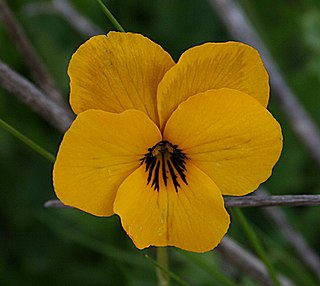
Viola pedunculata, the California golden violet, Johnny jump up, or yellow pansy, is a perennial yellow wildflower of the coast and coastal ranges in California and northwestern Baja California. The common name "Johnny jump up" is usually associated with Viola tricolor however, the introduced garden annual.

Potentilla douglasii is a species of flowering plant in the rose family known by several common names, including pinewoods horkelia and dusky horkelia. It is native to the western United States from California to Wyoming, where it is generally found in mountain forests and meadows.
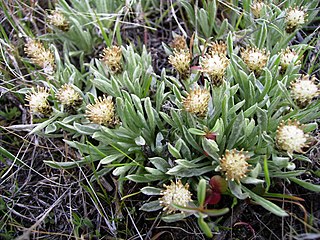
Antennaria dimorpha is a North American species of flowering plants in the family Asteraceae known by the common names low pussytoes or gray cushion pussytoes. It is native to western Canada and the western United States as far south as Riverside County in California and Rio Arriba County in New Mexico. It is generally found in dry areas. There are historical records of the species formerly occurring in northwestern Nebraska, but these populations appear now to be gone.
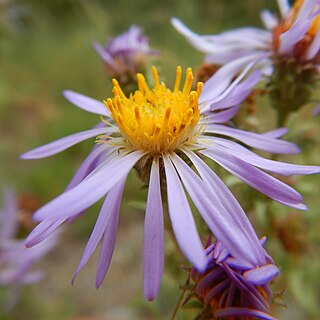
Symphyotrichum campestre is a species of flowering plant of the family Asteraceae commonly known as western meadow aster. It is native to much of western North America where it grows in many habitats, generally at some elevation.

Astragalus kentrophyta is a species of milkvetch known by the common name spiny milkvetch. It is native to western North America from central to west Canada, to California, to New Mexico. It grows in rocky mountainous areas, such as the Sierra Nevada, and on plateaus.

Microseris douglasii is a species of flowering plant in the family Asteraceae known by the common name Douglas' silverpuffs. It is native to western North America from Oregon and California to Baja California. It grows in several types of habitat, including grassland and vernal pools, and on soils containing clay and serpentine.

Sabulina douglasii is a species of flowering plant in the family Caryophyllaceae known by the common name Douglas' stitchwort.
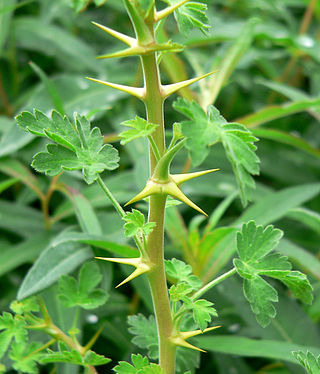
Ribes montigenum is a species of currant known by the common names mountain gooseberry, alpine prickly currant, western prickly gooseberry, and gooseberry currant. It is native to western North America from Washington south to California and east as far as the Rocky Mountains, where it grows in high mountain habitat types in subalpine and alpine climates, such as forests and talus. It is a spreading shrub growing up to 1.5 meters tall, the branching stems covered in prickles and hairs and bearing 1 to 5 sharp spines at intervals.

Silene douglasii is a species of flowering plant in the family Caryophyllaceae known by the common name Douglas's catchfly.

Engellaria obtusa is a species of flowering plant in the family Caryophyllaceae known by the common names Rocky Mountain chickweed, blunt-sepaled starwort, and obtuse starwort. It is the sole species in genus Engellaria. It is native to western North America, from British Columbia and Alberta to California to Colorado, where it grows in moist areas in forests and on mountain slopes.
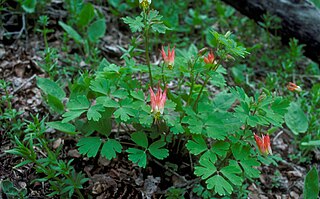
Aquilegia elegantula, the western red columbine, is a perennial species of flowering plant in the family Ranunculaceae, native to the Southwestern United States and northern Mexico.
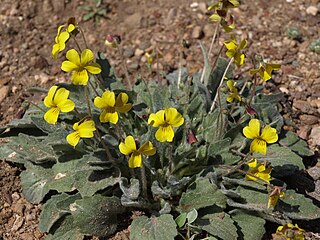
Viola purpurea var. aurea, also known as golden violet and bright yellow violet, is a variety of violet. It is endemic to the western United States, where it is known from scattered occurrences in various types of dry habitat such as the slopes of desert mountains.

Viola bakeri is a species of violet known by the common name Baker's violet. It is native to the Western United States, from Washington and Oregon, to the mountains of northern Nevada, and in California to the southern High Sierra Nevada.
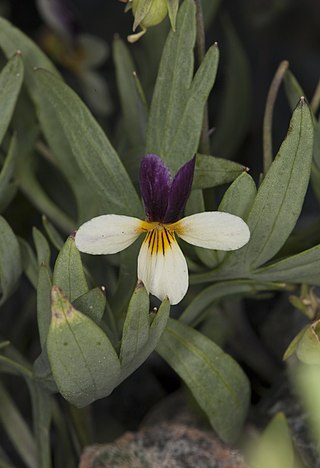
Viola hallii is a species of violet known by the common names Oregon violet and Hall's violet. It is native to southwestern Oregon and northwestern California, where it occurs in open areas in the forests and chaparral of the coastal mountain ranges, on gravelly soils, often of serpentine origin.
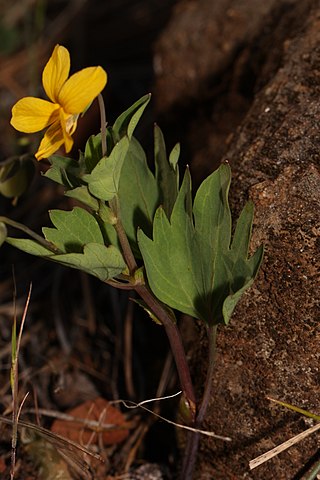
Viola lobata is a species of violet known by the common name pine violet. It is native to western North America from southern Oregon through California and into northern Baja California, where it occurs in mountain ranges and foothills. It grows in woodlands and other habitat. This rhizomatous herb produces an erect stem a few centimeters tall or growing to nearly half a meter in maximum height. The leaves have variously shaped blades borne on long petioles. The blades are 5 to 15 centimeters wide and may be hairless, hairy, or waxy in texture. The leaf blades are often divided into narrow lobes or dissected into small segments. The shape of the leaf blade differentiates the two subspecies; ssp. lobata has dissected leaves and ssp. integrifolia has entire or toothed blades. A solitary flower is borne on a long, upright stem. It has five yellow petals, all five or just the lower three with purple or brown veining and the upper two stained with purple or brown on the outer surfaces.

Viola ocellata is a species of violet known by the common names pinto violet, two-eyed violet, and western heart's ease. It is native to southern Oregon and northern and central California, where it occurs in the coastal foothills and mountain ranges. It sometimes grows in serpentine soils and in quicksilver mines.
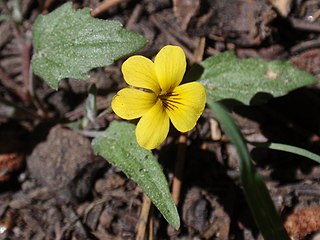
Viola pinetorum is a species of violet known by the common names goosefoot violet, goosefoot yellow violet, gray-leaved violet, or mountain yellow violet. It is endemic to California, where it grows in mountain ranges throughout the state. It occurs in various types of mountain habitat, including forests and talus. This herb grows from a tough taproot and produces an erect or decumbent stem up to about 22 centimeters long. The leaves are linear to oval in shape with pointed tips and toothed edges. The longest ones reach 15 to 20 centimeters in length. A solitary flower is borne on a long, upright stem. It has five yellow petals, the lowest three veined with brownish purple, and the upper two with brownish purple coloring on the outer surfaces.

Viola praemorsa is a species of violet known by the common names canary violet, Astoria violet, yellow montane violet, and upland yellow violet.
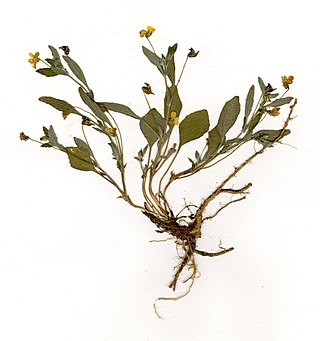
Viola tomentosa is a species of violet known by the common names feltleaf violet and woolly violet. It is endemic to the central Sierra Nevada of California, where it occurs in various types of dry mountain forest habitat. This small herb grows from a deep taproot, reaching a maximum height of 5 to 10 centimeters. The herbage is coated with woolly hairs. The leaves have oval blades borne on petioles a few centimeters long. A solitary flower is borne on a short upright stem. It is under a centimeter long with five yellow petals. The lower three petals are veined with dark brown and the upper two are stained brown or purplish on the back sides.

Penstemon pruinosus is a species of flowering plant in the plantain family; its common name is the Chelan penstemon. It is native to Washington State and southern British Columbia on the east side of the Cascade Mountains.





















